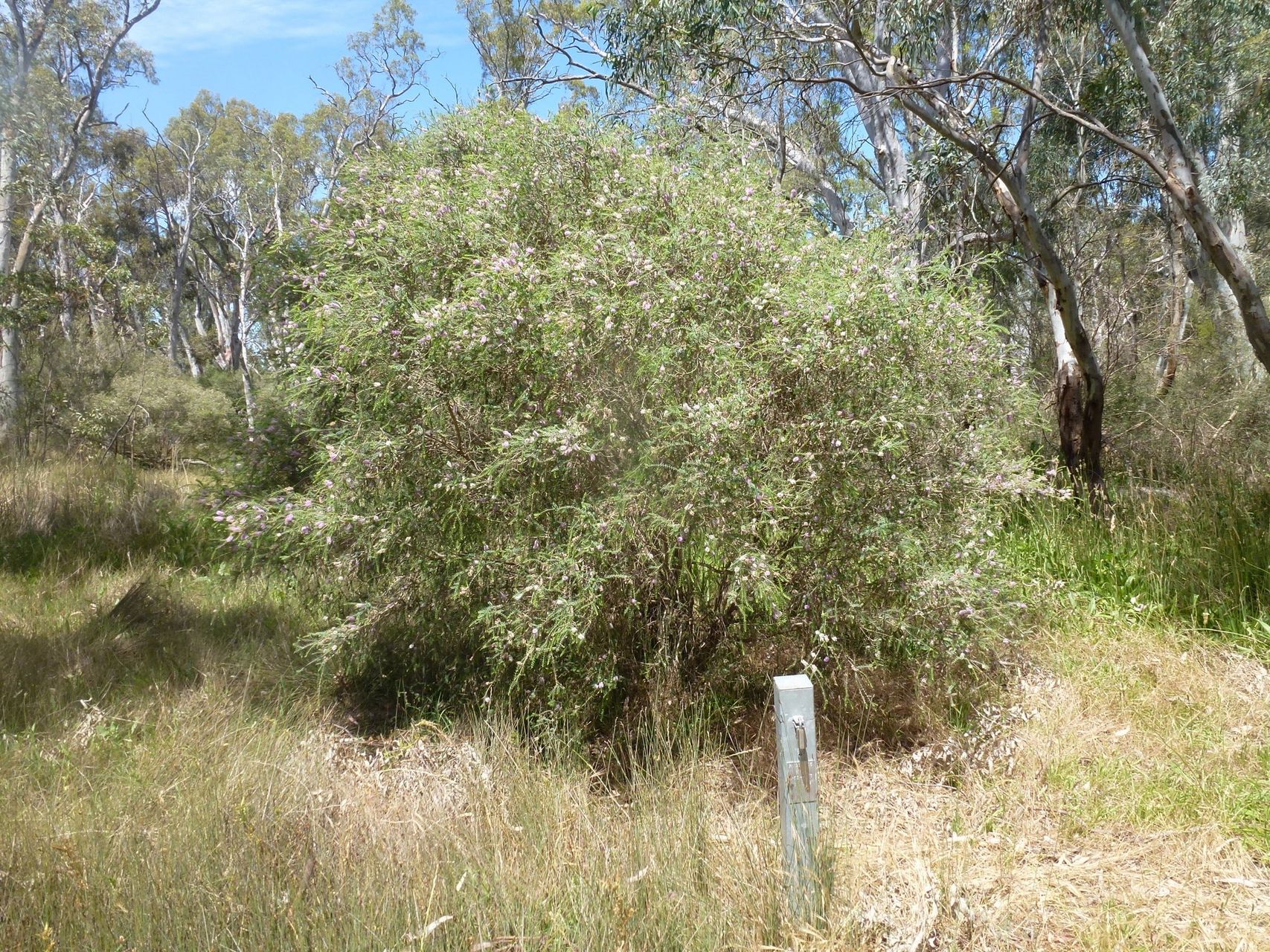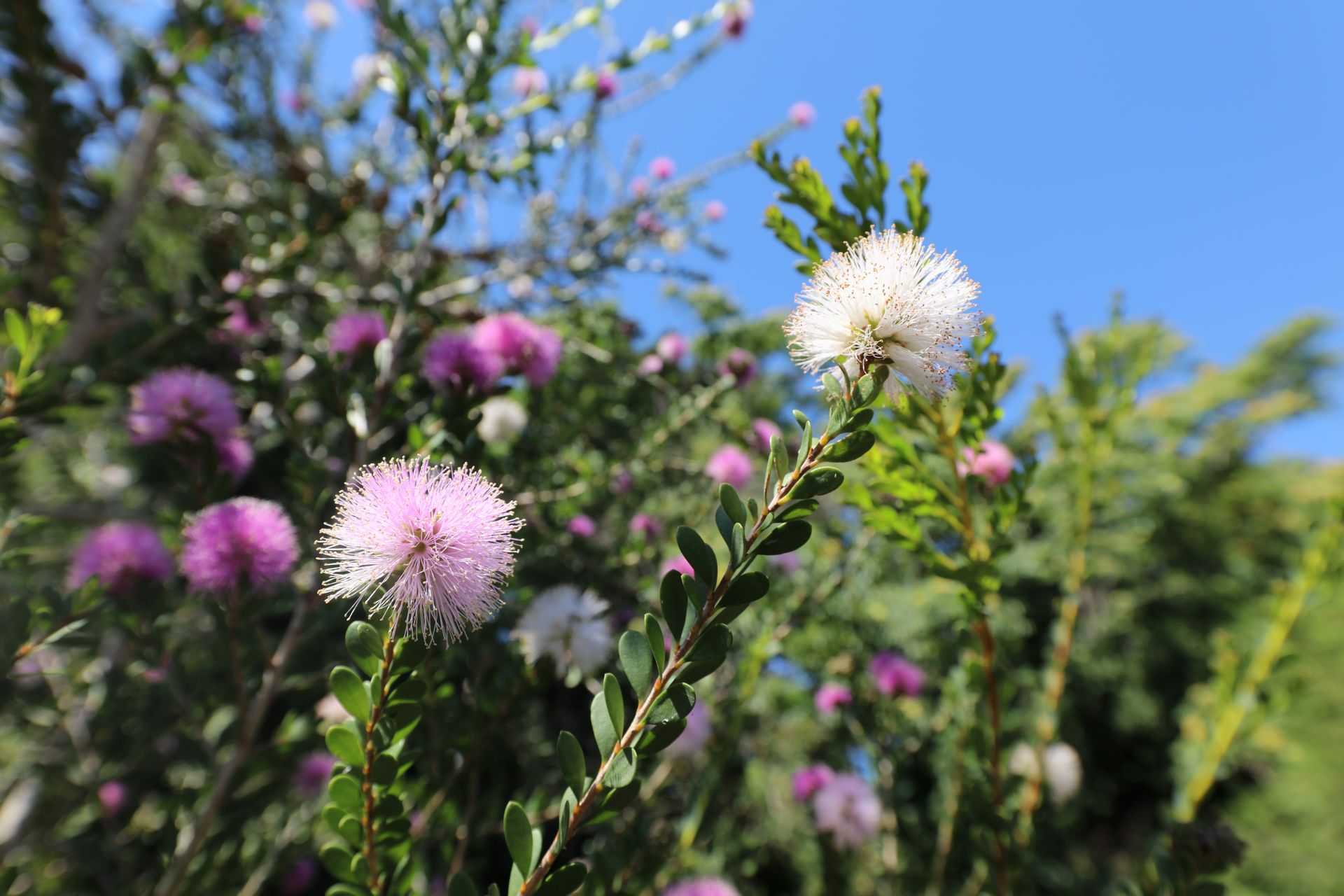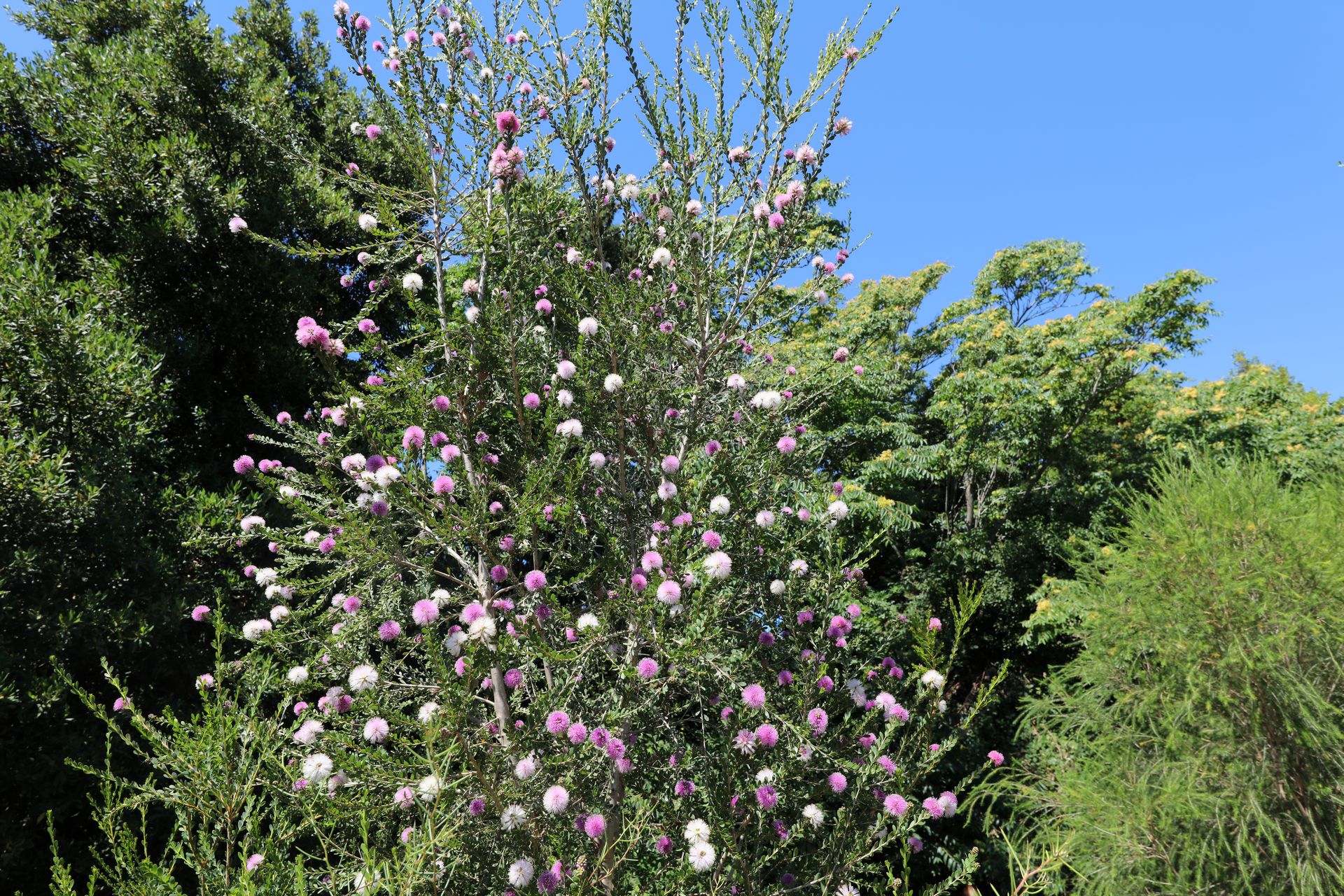Melaleuca decussata 3327
Author: Robert Brown (1773-1858)Family: Myrtaceae Subfamily: Myrtoideae Tribe: Melaleuceae
Genus: Melaleuca
English name: Cross-leaf Honey-myrtle
Zone: Australia
Description
This well-known species occurs from western Victoria to the Eyre Peninsula, South Australia. The plants usually grow in winter-wet sites and are found along the coast and in adjacent areas as well as some distance inland. The specific epithet means decussate, in reference to the leaves.

Melaleuca decussata Observed in Australia by Alan Dandie (license)
Botanical Description
It is a small to tall shrub (2-6m x 2-4,5m) with glabrous or faintly hairy young growth. The bark is slightly papery to hard. The branches are spreading to ascending, often many. The branchlets are spreading to ascending and sometimes pendant.
The leaves are 0,5-1,5cm x 0,1-0,4cm, linear to narrowly oblanceolate, decussate, sessile, often crowded, green to greyish-green, glabrous, undersurface with prominent glands. The apex is pointed or blunt.
The flowerheads are 2-3cm x 1cm, spikes on very short lateral shoots, scattered to profuse. Often conspicuous but can be partially hidden by foliage. The flowers are pink, purplish, violet, sometimes fading rapidly, or rarely white. The calyx tube is to about 0,1cm x 2cm. The petals are small.
The capsules are to about 0,4cm across, embedded in the inflated stem.
The leaves are 0,5-1,5cm x 0,1-0,4cm, linear to narrowly oblanceolate, decussate, sessile, often crowded, green to greyish-green, glabrous, undersurface with prominent glands. The apex is pointed or blunt.
The flowerheads are 2-3cm x 1cm, spikes on very short lateral shoots, scattered to profuse. Often conspicuous but can be partially hidden by foliage. The flowers are pink, purplish, violet, sometimes fading rapidly, or rarely white. The calyx tube is to about 0,1cm x 2cm. The petals are small.
The capsules are to about 0,4cm across, embedded in the inflated stem.

Useful plant
Enthusiasts have made a limited number of selections of this species, one of which has very decorative pendant growth. Plants are hardy to frosts and the respond well to regular pruning or clipping and are very useful for hedging, screening and general planting.
Medicinal plant
The leaf oil from this species is monoterpenoid in nature. The principal components are 1,8-cineole (53-63%), limonene (7-16%), a-pinene (1-8%), terpinen-1-ol (1-2%) and a-terpineol (3-5%). Sesquiterpenes do not contribute much to the oil, with the principal components being aromadendrene (1-4%), ß-caryophyllene (1-4%), viridiflorene (1-10%) and globulol (1-3%).
References
- Encyclopedia of Australian Plants, Elliot W. Rodger & Jones David L. 2012 pag. 333. ISBN
- Melaleucas a field and garden guide, Ivan Holliday. 1989 pag. 64-65. ISBN
- Melaleucas, Their botany, essential oils and uses, Joseph J. Brophy, Lyndley A. Craven & John C. Doran. 2013 pag. 141. ISBN
- Native trees and shrubs of South-Eastern Australia, Leon Costermans. 1996 pag. 250. ISBN
Medicinal plant
The leaf oil from this species is monoterpenoid in nature. The principal components are 1,8-cineole (53-63%), limonene (7-16%), a-pinene (1-8%), terpinen-1-ol (1-2%) and a-terpineol (3-5%). Sesquiterpenes do not contribute much to the oil, with the principal components being aromadendrene (1-4%), ß-caryophyllene (1-4%), viridiflorene (1-10%) and globulol (1-3%).
References
- Encyclopedia of Australian Plants, Elliot W. Rodger & Jones David L. 2012 pag. 333. ISBN
- Melaleucas a field and garden guide, Ivan Holliday. 1989 pag. 64-65. ISBN
- Melaleucas, Their botany, essential oils and uses, Joseph J. Brophy, Lyndley A. Craven & John C. Doran. 2013 pag. 141. ISBN
- Native trees and shrubs of South-Eastern Australia, Leon Costermans. 1996 pag. 250. ISBN

References for the genus
- Encyclopedia of Australian Plants, Elliot W. Rodger & Jones David L. 2012 pag. 81,315-318,436. ISBN
- A review of Melaleuca L.(Myrtaceae) in South Australia, Carrick, John and Chorney, K. Journal of the Adelaide Botanic Garden 1979 pag. 281-319. JStor
- A revision of Melaleuca L. (Myrtaceae) in Northern and Eastern Australia, 1, Byrnes, N.B. Austrobaileya 1984 Vol. 1(1) pag. 65-76. DOI
- A revision of Melaleuca L. (Myrtaceae) in Northern and Eastern Australia, 2, N.B. Byrnes. Austrobaileya 1985 Vol. 2(2) pag. 131-146. JStor
- A revision of Melaleuca L. (Myrtaceae) in Northern and Eastern Australia, 3, Byrnes, N.B. Austrobaileya 1986 Vol. 2 pag. 254-273. DOI
- A revision of the genus Eremaea (Myrtaceae), Hnatiuk, RJ. Nuytsia 1993 Vol. 9(2) pag. 137-222. Address
- A taxonomic revision of Beaufortia (Myrtaceae: Melaleuceae)., Burbidge, Andrew A. Nuytsia 2016 Vol. 27. Address
- A taxonomic revision of the genus Calothamnus Labill.(Myrtaceae: Leptospermoideae). Part 1. The 4-merous species [Western Australia], Hawkeswood, TJ. Nuytsia 1987 Vol. 6(1) pag. 67-126. Address
- Melaleuca revisited: cpDNA and morphological data confirm that Melaleuca L.(Myrtaceae) is not monophyletic, Edwards, Robert D and Craven, Lyn A and Crisp, Michael D and Cook, Lyn G. Taxon 2010 Vol. 59(3) pag. 744-754. Address
- Melaleucas a field and garden guide, Ivan Holliday. 1989. ISBN
- Melaleucas, Their botany, essential oils and uses, Joseph J. Brophy, Lyndley A. Craven & John C. Doran. 2013. ISBN
- Molecular phylogeny and biogeography of Melaleuca, Callistemon and related genera (Myrtaceae), Brown, Gillian K and Udovicic, Frank and Ladiges, Pauline Y. Australian Systematic Botany 2001 Vol. 14(4) pag. 565-585. ResearchGate
- New combinations and names in Melaleuca (Myrtaceae), Craven, Lyn A and Edwards, Robert D and Cowley, Kirsten J. Taxon 2014 Vol. 63(3) pag. 663-670. DOI
- New names and combinations for some Melaleuca (Myrtaceae) species and subspecies from the south-west of Western Australia considered rare or threatened, Quinn, Francis C. and Cowley, K J and Barlow, Bryan A. (Bryan Alwyn), and Thiele, Kevin,. Nuytsia 1992 Vol. 8 pag. 333-350. Address
- Nine new species of Calothamnus Labill. (Myrtaceae: Leptospermoideae) from Western Australia, Hawkeswood, Trevor. Nuytsia 1984 Vol. 5(1) pag. 123-153. ResearchGate
- Notes on Conothamnus Lindl. with the description of a new section, sect. Gongylocephalus Craven (Myrtaceae), Craven, Lyndley. Muelleria: An Australian Journal of Botany 2002 Vol. 16 pag. 39-42. DOI
- How to grow Bottle Brushes. Australian Plants 1960 Vol. 1(3). Address
- The use of Trees and Shrubs in the Dry Country of Australia, Norman Hall. 1972 pag. 386. ISBN
- A review of Melaleuca L.(Myrtaceae) in South Australia, Carrick, John and Chorney, K. Journal of the Adelaide Botanic Garden 1979 pag. 281-319. JStor
- A revision of Melaleuca L. (Myrtaceae) in Northern and Eastern Australia, 1, Byrnes, N.B. Austrobaileya 1984 Vol. 1(1) pag. 65-76. DOI
- A revision of Melaleuca L. (Myrtaceae) in Northern and Eastern Australia, 2, N.B. Byrnes. Austrobaileya 1985 Vol. 2(2) pag. 131-146. JStor
- A revision of Melaleuca L. (Myrtaceae) in Northern and Eastern Australia, 3, Byrnes, N.B. Austrobaileya 1986 Vol. 2 pag. 254-273. DOI
- A revision of the genus Eremaea (Myrtaceae), Hnatiuk, RJ. Nuytsia 1993 Vol. 9(2) pag. 137-222. Address
- A taxonomic revision of Beaufortia (Myrtaceae: Melaleuceae)., Burbidge, Andrew A. Nuytsia 2016 Vol. 27. Address
- A taxonomic revision of the genus Calothamnus Labill.(Myrtaceae: Leptospermoideae). Part 1. The 4-merous species [Western Australia], Hawkeswood, TJ. Nuytsia 1987 Vol. 6(1) pag. 67-126. Address
- Melaleuca revisited: cpDNA and morphological data confirm that Melaleuca L.(Myrtaceae) is not monophyletic, Edwards, Robert D and Craven, Lyn A and Crisp, Michael D and Cook, Lyn G. Taxon 2010 Vol. 59(3) pag. 744-754. Address
- Melaleucas a field and garden guide, Ivan Holliday. 1989. ISBN
- Melaleucas, Their botany, essential oils and uses, Joseph J. Brophy, Lyndley A. Craven & John C. Doran. 2013. ISBN
- Molecular phylogeny and biogeography of Melaleuca, Callistemon and related genera (Myrtaceae), Brown, Gillian K and Udovicic, Frank and Ladiges, Pauline Y. Australian Systematic Botany 2001 Vol. 14(4) pag. 565-585. ResearchGate
- New combinations and names in Melaleuca (Myrtaceae), Craven, Lyn A and Edwards, Robert D and Cowley, Kirsten J. Taxon 2014 Vol. 63(3) pag. 663-670. DOI
- New names and combinations for some Melaleuca (Myrtaceae) species and subspecies from the south-west of Western Australia considered rare or threatened, Quinn, Francis C. and Cowley, K J and Barlow, Bryan A. (Bryan Alwyn), and Thiele, Kevin,. Nuytsia 1992 Vol. 8 pag. 333-350. Address
- Nine new species of Calothamnus Labill. (Myrtaceae: Leptospermoideae) from Western Australia, Hawkeswood, Trevor. Nuytsia 1984 Vol. 5(1) pag. 123-153. ResearchGate
- Notes on Conothamnus Lindl. with the description of a new section, sect. Gongylocephalus Craven (Myrtaceae), Craven, Lyndley. Muelleria: An Australian Journal of Botany 2002 Vol. 16 pag. 39-42. DOI
- How to grow Bottle Brushes. Australian Plants 1960 Vol. 1(3). Address
- The use of Trees and Shrubs in the Dry Country of Australia, Norman Hall. 1972 pag. 386. ISBN
General specifications
Biological type: shrub
Frost resistance: 14ºF
Leaf color: dark green
Flower color: mauve
Specifications for the Mediterranean basin
Adult size (h x w): 16,4ft x 13,1ft
Sun exposure: full sun (Sun hours: >6h Foliage: evergreen
Growth: fast
Flowering time from April until August
Specific information for our garden
Planting substrate: 30%Compost+30%Coco+40%Sand
Plant watering: 3x a week pH 6.5
Logical sequence of containers for: Eucalyptus; forestry plate 8cm, forestry pot 3L, Airpot 12L, Airpot 50L, Airpot 800L
Propagation is done by cuttings
Units in the garden: 2x
Ecology in its country of origin
Rainfall: 300-900mm
Limestone soil: a little
Acidic soil: a little
Coastal soil: much
Frost resistance: 14ºF
Leaf color: dark green
Flower color: mauve
Specifications for the Mediterranean basin
Adult size (h x w): 16,4ft x 13,1ft
Sun exposure: full sun (Sun hours: >6h Foliage: evergreen
Growth: fast
Flowering time from April until August
Specific information for our garden
Planting substrate: 30%Compost+30%Coco+40%Sand
Plant watering: 3x a week pH 6.5
Logical sequence of containers for: Eucalyptus; forestry plate 8cm, forestry pot 3L, Airpot 12L, Airpot 50L, Airpot 800L
Propagation is done by cuttings
Units in the garden: 2x
Ecology in its country of origin
Rainfall: 300-900mm
Limestone soil: a little
Acidic soil: a little
Coastal soil: much
Sowing instructions
SPRING Sow the seeds on the surface of Well Drained Seed Sowing Mix between 68-77°F. During germination keep the substrate moist and in daylight. The seeds germinate in 3-6 weeks.
Germination references for the genus
- How to grow Bottle Brushes. Australian Plants 1960 Vol. 1(3). Address
Cuttings instructions
Take the cuttings in early spring, soak them in a hormonal preparation for cuttings. Plant them in a substrate rich in perlite and keep them sufficiently moist in sealed freezer bags.
Germination references for the genus
- How to grow Bottle Brushes. Australian Plants 1960 Vol. 1(3). Address
Cuttings instructions
Take the cuttings in early spring, soak them in a hormonal preparation for cuttings. Plant them in a substrate rich in perlite and keep them sufficiently moist in sealed freezer bags.
Experiences in the garden
04-10-16A Obtaining 4 plants from nursery Arven
19-12-24 4x Dead plant due to root competition: JTAust.
03-11-17B Obtaining seeds from seed provider Wildseed Tasmania.
02-04-19 Sown seeds in a tray and germinated at 26-04-19.
Protocol: Spring Surface Sowing mix+Sand 64-72°F Damp substrate+Light 3-6w
10-04-18C Obtaining 8 plants from nursery Issa, they are in our nursery Resin31 6x C110 and planted in zone(s) Poetes
22-02-19 2x Dead plant due to repotting: Ombr14d A3.
26-07-18D Obtaining 8 plants from nursery Issa, they are in our nursery Resin31 6x C110
27-05-20 1x Dead plant because of watering problem.
. . . 2019B Production of 53 plants in our nursery: Euc17 22x A45 Ombr4g 21x A12
11-08-20 6x Dead plant because of substrate problem: Serre7 F3.
01-10-21 2x Dead plant: No information: Ombr3g C6.
30-07-24 2x Dead plant due to too less sun: Euc17 A45 Ombr3g A12.